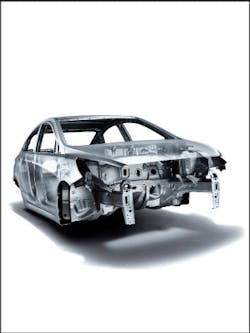Get Ready for Aluminum
Repairing today’s vehicles isn’t like it used to be. The days of learning one general repair process to work across all vehicle makes are gone. With the advent and increased usage of higher-strength materials, all of which work differently, repair decisions must now be based on vehicle designs rather than the type of damage.
Aluminum is one type of material gaining popularity among auto manufacturers. Jamie Boettcher, instructional designer and trainer for I-CAR, says the metal is quite different from high-strength steels. He discusses the characteristics of aluminum, and what repairers need to know to understand whether their shop is ready to handle modern aluminum designs.
The need to boost fuel economy to 54.5 mpg by 2025 is driving auto manufacturers to reduce vehicle weight. They are accomplishing that, while improving safety, by using higher-strength, lighter-weight materials such as aluminum. According to the Aluminum Association, auto manufacturers will increase use of aluminum components from an average 327 pounds per vehicle in 2009 to 550 pounds by 2025.
Most cars today already contain some amount of aluminum. Many high-volume production domestic cars have an aluminum hood, deck lid, trunk lid or fender. And many high-end vehicles, especially European makes, have full aluminum structures. A few examples include Aston Martin, Jaguar, Ferrari, Lamborghini and Corvette. It’s expected that full aluminum structures will become more common in high-volume cars within the next few years.
That change in vehicle design will affect all repairers. Technicians cannot perform the same processes and procedures on aluminum compared with high-strength steels. It’s becoming increasingly important for shops to spend time up front identifying vehicle designs, and making assessments on whether their shop has the proper training, tools and equipment to work with aluminum.
Aluminum does have some repairability, but it’s very difficult because of the following characteristics:
• Hardness: Aluminum is very stiff and doesn’t have a lot of memory. Many aluminum parts, especially exterior components, are designed with 6000-series aluminum. That’s a rigid, bake-hardened alloy meant to prevent dings and dents. But that level of hardness makes it challenging to do any shrinking or stress relieving.
• Conductivity: Steel components hold heat in one location, without transferring high temperatures throughout a part. Aluminum, on the other hand, disperses heat completely throughout a part, which makes heating one specific area for repairs very difficult.
• Temperature retention: Steel can be heated to very high temperatures and maintains warmth for an extended length of time, which allows technicians to work on one spot for a longer duration. Aluminum can only be heated to a maximum of 500 degrees, and it cools off quickly.
• Corrosion: Galvanic corrosion can be a problem with aluminum. The material corrodes and reduces longevity when it comes in contact with steel or carbon components. Carbon is found in things such as windshield urethane and body grommets. Using the wrong windshield urethane or replacement grommet could cause a negative reaction.
Those characteristics drive different repair theory compared to other materials, both on the exterior and structure. On aluminum exteriors, pulling out damage must be completed slowly over time, while only heating it enough to soften the molecules slightly. It requires light and gentle hammering, dollying and pushing to make repairs, which takes a lot of patience and time. Structurally, many auto manufacturers do not recommend straightening aluminum. Shops typically need to replace entire parts if structural damage exceeds more than a few millimeters. That may drive an increased number of replace-versus-repair decisions.
The characteristics of aluminum require shops to make certain facility upgrades. The first upgrade is your toolbox. You need to have specific riveting tools to remove and install self-piercing rivets and blind rivets. Each auto manufacturer also requires shops to purchase specific welders capable of performing the pulse spray transfer method. Your tool supplier should be able to provide you with resources regarding all of the equipment upgrades that are necessary for your shop.
It’s critical to eliminate all possible contaminants around aluminum components. That also causes shops to need entirely separate sets of aluminum-only tools to prevent cross-contamination, such as wrenches, hammers, dollies, sanders and grinders.
A high level of training is the most important issue when it comes to aluminum. Technicians should constantly read books, assess technical bulletins and invest in manufacturer-specific classes. I-CAR is also releasing a new aluminum repair program toward the end of 2012 that will cover everything shops need to know about working with the material.
